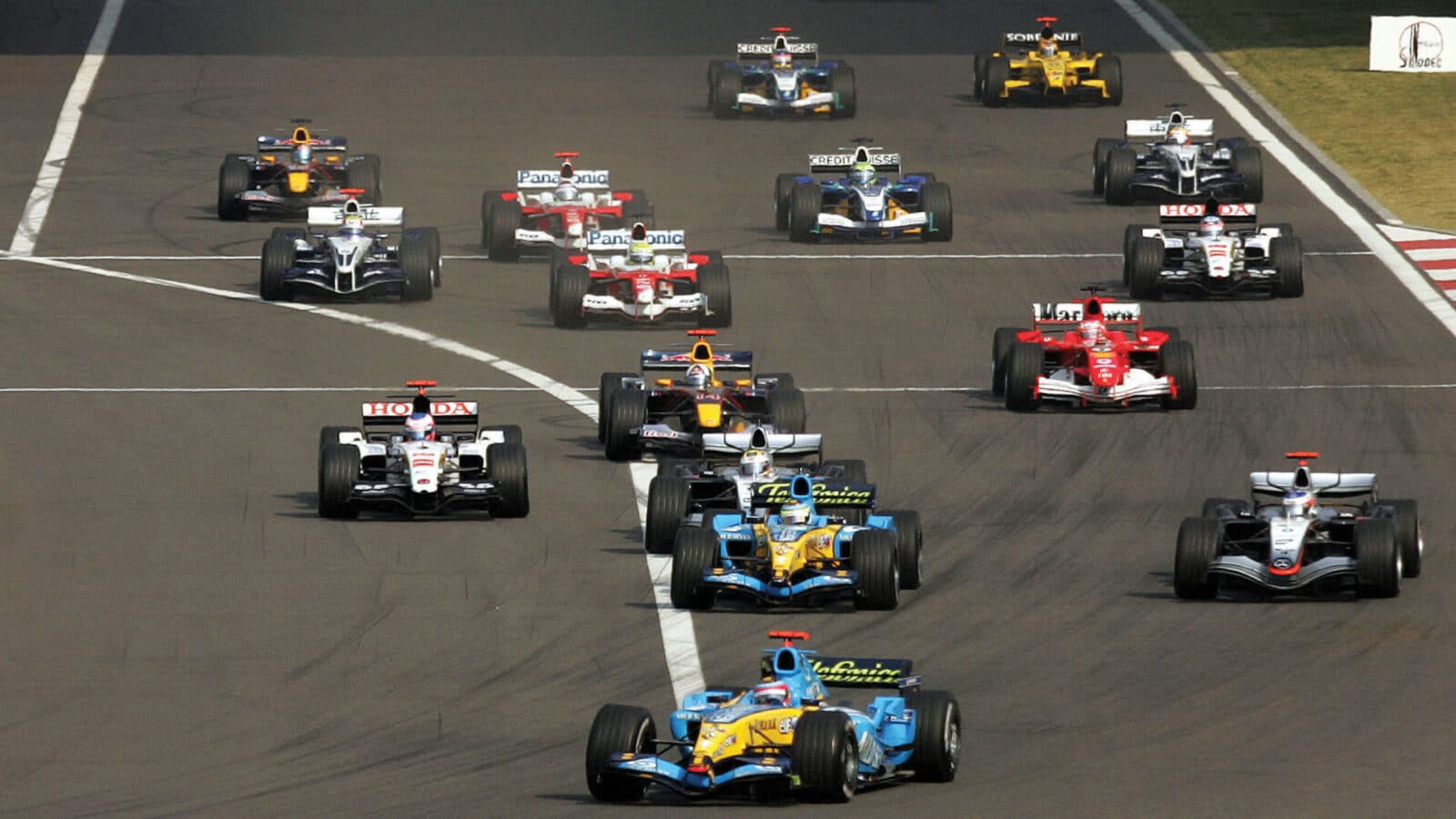The call of F1 V10 engines is still howling, two decades after their demise
Our ears may be thankful, but, says Doug Nye, the heart misses the V10 howl that was the soundtrack to F1 races 20 years ago

The Chinese GP in 2005 marked the end for the 3-litre V10 engine configuration in Formula 1
Getty Images
Beyond school leaving age many old snowies such as myself assure our young friends that the answer to what seems to accelerate quicker than a 1000hp half-tonner can be the passage of time itself.
Rummaging about in ‘recent’ Formula 1 history it dawned on me that the ear-piercing scream of the 10-cylinder engine – to some just a thrilling delight, to others a hideous symptom of uncaring eco-unfriendly high-tech – was last properly heard in anger 20 years ago.
The 2005 World Championship series had ended in the second Chinese GP, held at the Hermann Tilke-designed Shanghai circuit at Jiading. Costing a reputed $240m (£130m) it would reign for five years (until Abu Dhabi blew that record away with a claimed bill of $1bn – £737.1m) as the most costly F1 venue.
Not far behind was the F1 manufacturers’ engine bill, following a period during which V10s had effectively overpowered the classical V12 configuration to the point of making it obsolete. Naturally aspirated F1 engines had become mandatory from 1989, when Honda and Renault both took the V10 route for their new 3.5-litre power units. In part the driver deaths of 1994 promoted the FIA’s cut in engine capacity to 3 litres for 1995 and Renault’s V10s still reigned supreme.
And at the end of 2005 the mandatory capacity limit was cut further to 2.4 litres and the maximum eligible number of cylinders to eight. Thinking was that this should reduce peak power by around 200bhp – adding 3-5sec to most lap times. As ever F1 engineers showed all what Americans might term ‘their smarts’, and early in 2006 lap times were hardly any slower, and in some cases notably quicker.
“Renault’s V10 engine proved better than Mercedes’ rival FO 110R”
Over the years since that tone change of 2005-06, there has been at least as much – if not more – enthusiast nostalgia for the skull-splitting 19,000rpm V10s of 1995-2005, as many of us had before that for the traditional V12s. The truth that several of the smaller-capacity new V8s achieved the same and later even higher rpm was submerged by the different audible pitch of their flat-out note.
While the notable end of an engine formula in 2005 is mirrored by this year’s end of a descendant formula, 20 years ago Ferrari tumbled down the pecking order in a memorable fall from grace. That the Maranello team scraped together sufficient end-of-season points to finish third in the F1 Constructors’ Championship was thanks largely to their 1-2 success in the pathetic six-starters Indianapolis round – shredded by Michelin tyre inadequacies dramatically highlighted during practice and qualifying. But Michelin’s rival Bridgestone was in broad-based trouble, which Bridgestone/Ferrari simply took too long to appreciate and address.
Among the FIA’s regulation changes for F1 through 2005 had been the outlawing of mid-race tyre changes. Instead, each driver had to use one set of tyres during qualifying and the race. The reason for this was cited as being to motivate the teams to run harder-compound tyres, generating lower grip, reducing cornering speeds, improving safety… Now tyre changes were only permitted for punctures and wet weather.
At the Nürburgring Kimi Räikkönen’s McLaren crashed spectacularly after vibration from a flat-spotted tyre caused the attached carbon-composite suspension to disintegrate. The FIA and principals agreed that a single tyre change per car could be made without penalty, provided it was to change a tyre that had become dangerously worn. While in essence race-long tyre preservation became a new challenge for drivers; tyre manufacturers – Bridgestone and Michelin – had to step up to the plate with race-distance durability.
This wrecked Ferrari’s hunt for a seventh consecutive Constructors’ title. Technical director Ross Brawn explained: “The whole Bridgestone philosophy over the past few years has been focused on a 20-lap tyre that’s then finished; high degradation and high performance. Michelin often didn’t change tyres so for it to make the progression to 2005 rules [no tyre changes] it didn’t have to change much of its culture… Ferrari and Bridgestone had to start again and perhaps we didn’t appreciate this in the off-season…”.
In contrast the combination of the Renault R25, Michelin tyres and Fernando Alonso (remember him?) proved superb – even though the McLaren MP4-20/Kimi Räikkönen/Juan Pablo Montoya package often proved faster they lost their title through management-cum-engineering over-caution and unreliability.
But overall Alonso’s Renault 72-degree V10 engine proved better in all-round respects than Mercedes’ rival FO 110R unit. Renault engine production headed by Rob White effectively played a blinder although significant performance development apparently lagged, which is unsurprising in the last year of one engine formula, while investment had to take precedence in the onrushing new year’s replacement design. Renault still deployed its V10 engines in three different specs that year, achieving ever higher peak rpm, with the chassis capacity to make the most of it.
Then engineering director Pat Symonds would confirm that Alonso “never had an off day… just an off second” – when he hit the wall in Canada – but was otherwise almost faultless. And unlike the V10 engine, Alonso is currently still in play – 20 years later. Bravo!

